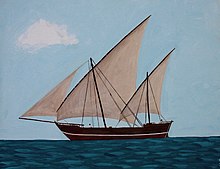Bowsprit

The bowsprit of a sailing vessel is a spar extending forward from the vessel's prow. It provides an anchor point for the forestay(s), allowing the fore-mast to be stepped farther forward on the hull.[1]
Origin

The word bowsprit is thought to originate from the Middle Low German word bōchsprēt - bōch meaning bow and sprēt meaning pole.[2] Early ocean-going vessels tended to tilt the bowsprit, also known in centuries past as a boltsprit, at a high angle, and hung one or two square spritsails from yards. In the 17th century and early 18th century a vertical sprit topmast was added near the end of the bowsprit and another square sail added to it; this was not a particularly successful design however, the mast tending to carry away in heavy weather. Fore-and-aft sails known as jibs hung from the stays proved more useful for speed and manoeuvring, and the basic bowsprit was lengthened with a jibboom and then even further with a flying jibboom, resulting in bowsprits of tremendous length, up to 30 metres total.[citation needed]
Small ships

Many types of small pleasure and work vessels ship bowsprits, generally short in length. Once popular on yachts large and small, even after the popularization of the Bermuda rig, they have fallen out of fashion. On some modern racing yachts and dinghies, the bowsprit is retractable and primarily used to fly an asymmetrical spinnaker.[citation needed]
Tall ships

The bowsprit on a tall ship may be of considerable length and carry several forestays supporting the foremast. Headsails are stowed by tying onto the bowsprit when not in use. To minimise the risk of bowsprit and crew handling sail on it being buried in large waves, it is normally angled upwards from the horizontal.[citation needed]
Hang gliders
Some hang gliders use a bowsprit, rather than a spar to spread their wings. The bowsprit is formed by extending the keel tube about a metre beyond the leading edge of the wing. In 1879 a patent in England by F. W. Brearey[3] was filed (followed by U.S. patenting in numbers 234947[4] and 320042 [5]) that taught bowsprit structure for flying machines. In the modern mid-1900s renaissance in hang gliding a Dial Soap TV commercial featured in 1973 a bowsprit cross-sparless hang glider.[6] Other examples of bowsprit hang gliders were exampled in the gliders manufactured by Bautek in the 1980s.[7]
References
- ^ "Bitts & Bobs(tays)". CLASSIC MARINE. Archived from the original on 21 December 2012. Retrieved 15 November 2012.
{{cite web}}: Unknown parameter|deadurl=ignored (|url-status=suggested) (help) - ^ "Bowsprit". Dictionary.com. Retrieved 15 November 2012.
- ^ "Frederick William Brearey". The Pioneers : An Anthology. CTIE. 2002-01-30. Retrieved 2012-11-15.
- ^ "Patent US234947". Google.com. Retrieved 2012-11-15.
- ^ "Patent US320042". Google.com. Retrieved 2012-11-15.
- ^ "Hang Glider Timeline EnterData". Energykitesystems.net. Retrieved 2012-11-15.
- ^ "BAUTEK (Hang glider manufacturer)". Delta Club 82. Retrieved 2012-11-15.
